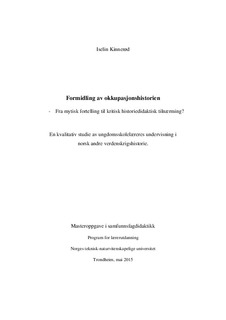| dc.contributor.author | Kinnerød, Iselin | |
| dc.date.accessioned | 2017-03-20T12:35:17Z | |
| dc.date.available | 2017-03-20T12:35:17Z | |
| dc.date.issued | 2015 | |
| dc.identifier.uri | http://hdl.handle.net/11250/2434712 | |
| dc.description.abstract | Temaet for masteroppgaven er formidlingen av norsk okkupasjonshistorie i ungdomsskolen. Forskningsspørsmålene utdyper oppgavens fokusområder, som baserer seg på hvorvidt formidlingen reflekterer en mytisk og fellesskapsdannende, eller en kritisk, analyserende og drøftende inngang til okkupasjonshistorien. Dette blir undersøkt gjennom kvalitative intervjuer med ni lærere i tre ulike landsdeler. I tillegg studeres lærebøkene de benytter, læreplanen Kunnskapsløftets samfunnsfagdel, samt Europarådets anbefalinger for god historieundervisning i et demokratisk Europa.
Bakgrunnen for oppgaven er at det i historieforskning og i offentlige debatter har vært påpekt at historieskrivingen om okkupasjonstiden i Norge lenge har vært preget av et mytisk «masternarrativ» med få nyanser. Ut fra tidligere forskningsarbeider gjorde jeg meg antakelser om at okkupasjonshistorien fremdeles formidles med mytiske trekk og forestillinger i ungdomsskolen, men også at det kildekritiske aspektet er framtredende. Hensikten med oppgaven er å rette fokus på at historiske hendelser ofte blir formidlet med mytiske aspekter som forenkler aktørers handlingsvalg. Det er et mål å belyse at et slikt syn på fortiden er utilstrekkelig.
Jeg har undersøkt lærernes formidling gjennom fire punkter: 1) deres holdning og begrunnelse for historielæring, 2) kildebruk, temaer og undervisningsformer, 3) vektlegging av historieskriverens definisjonsmakt og 4) historiebruk, fellesskap og identitet. Ut fra dette har jeg kommet fram til åtte strategier lærerne tar i bruk i okkupasjonshistorieundervisningen: tre mytiske tilnærminger, tre kritiske og to som knytter sammen det mytiske og det kritiske.
Det viser seg at lærerne i stor grad legger opp til en personlig inngang til okkupasjonshistorien, gjennom fortellinger tilknyttet familie og lokalmiljø. Sammenknytning mellom fortid, nåtid og framtid står også fram som sentralt i deres undervisning. Likevel viser materialet en todeling i forhold til om undervisningen først og fremst er faktaorientert eller hovedsakelig drøftingsbasert. Kildekritikk er en sentral, kritisk strategi, men kildegranskingen tar stort sett ikke hensyn til det mentale skillet mellom fortid og historie. Sammenknytningen mellom kritiske og mytiske undervisningsstrategier viser seg i arbeid med holdninger og verdier, men knyttes i liten grad opp til arbeid med flerkulturell forståelse i klasserommet.
I undersøkelsen av lærebøkene viste det seg å komme fram et nytt perspektiv, eller en ny side ved historien. Når to av lærebøkene verken formidler et mytisk eller kritisk narrativ, stiller jeg spørsmål til hvorvidt historien også har en tredje side, bestående av fakta og ferdigheter? | nb_NO |
| dc.description.abstract | This thesis deals with the teaching of Norwegian occupation history in lower secondary schools. Two research questions elaborate the main focus areas, which are based on whether the teaching reflects a mythical and community-forming, or critical analysis discursive approach to the field. This is studied through qualitative interviews with nine teachers in three different parts of Norway. In addition their set textbooks, the curriculum "Kunnskapsløftets" section of Social Studies and Council of Europe recommendations for good history teaching in a democratic Europe, are aspects of examination.
The reason for this choice of topic is that it has been pointed out in historical research that historical writing about the occupation period in Norway has long been characterized by a mythical "master narrative" with few nuances. Based on previous research, I made an assumption that occupation history is still conveyed with mythical traits and notions in lower secondary schools, but also that the source-critical aspect is prominent. The purpose of this thesis is to illustrate that historical events are often communicated with mythical aspects that simplify actions taken by people. The aim is to illuminate that such a view of the past is inadequate.
I have examined teaching methods through four points: 1) Their attitude and reasons for learning history, 2) Use of various sources, topics and teaching methods, 3) Emphasis on historians power of definition and 4) use of history, sense of community and identity. From this, I have arrived at eight main strategies used when teaching occupation history. Three mythical approaches, three critical and two that combine the mythical and the critical aspects.
It turns out that teachers largely choose an approach personalizing the teaching of occupation history, through stories associated with family and local community. Links between past, present and future are also central in their teaching. Nevertheless, the material has a dichotomy in relation to whether the teaching is primarily factual or mainly discussion-based. Evaluating sources is a key critical strategy but source-investigation does not demand the mental distinction between past and history. The link between critical and mythical teaching strategies appears to work on attitudes and values, but is linked, to a limited extent, to work with multicultural understanding in the classroom.
In the survey of the textbooks, a new perspective or a new aspect of history was revealed. When two of the textbooks convey neither a mythical nor a critical narrative, I raise the question as to whether history also has a third side, consiting facts and skills? | nb_NO |
| dc.language.iso | nob | nb_NO |
| dc.publisher | NTNU | nb_NO |
| dc.title | Formidling av okkupasjonshistorien - Fra mytisk fortelling til kritisk historiedidaktisk tilnærming? - En kvalitativ studie av ungdomsskolelæreres undervisning i norsk andre verdenskrigshistorie | nb_NO |
| dc.type | Master thesis | nb_NO |
| dc.subject.nsi | VDP::Samfunnsvitenskap: 200::Pedagogiske fag: 280::Fagdidaktikk: 283 | nb_NO |
